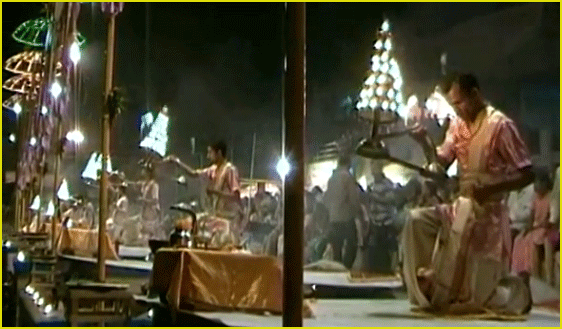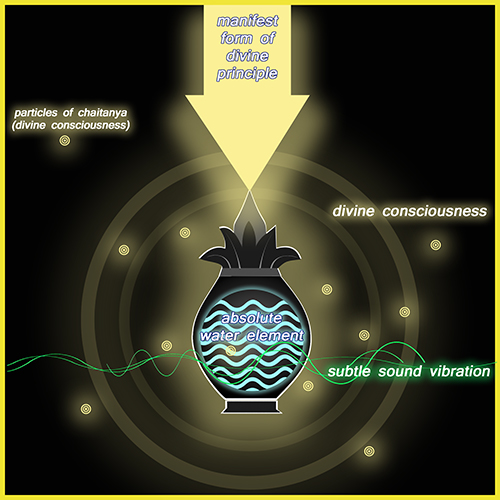
|
|
|
PŪJĀ

In many traditions such as Hinduism, Buddhism, Jainism and Sikhism, Pūjā is the ritual of worship, it is the offerings to the divine. There are various ways of celebrating Pūjā and every tradition has developed its own rituals varying significantly between regions, temples and occasions.
In Hinduism we could synthesize 16 basic steps (ṣoḍaśa upacāra) common to all varieties of pūjā:
Avahana - Invocation.
Asana - Offering of place.
Padya - Symbolic washing of the feet.
Arghya - Symbolic washing of the head and body.
Acamanīya - Symbolic washing of the mouth.
Snana - Symbolic Bath.
Vastra - Dressing.
Upavīda o Mangalsutra - Offering of the Sacred Thread (Janeu o Yaj˝opavītam).
Anulepana o Gandha. Offering of oils and perfumes, sandal paste, kumkum.
Pushpa - Offering of flowers.
Dhupa - Offering of incense.
Dipa o Aarti - Offering of fire.
Naivedya - Offering of food.
Namaskara o Pranama - Offering of salutations.
Parikrama - Ritual turning around the deity.
Leave.
Mantras
|
ॐ आवाहनं समर्पयामि |
oṁ āvāhanaṁ samarpayāmi |
Invocation |
|
ॐ आसनं समर्पयामि |
oṁ āsanaṁ samarpayāmi |
Offering of place |
|
ॐ पाद्यं समर्पयामि |
oṁ pādyaṁ samarpayāmi |
Symbolic washing of the feet |
|
ॐ अर्घ्यं समर्पयामि |
oṁ arghyaṁ samarpayāmi |
Symbolic washing of the head and body |
|
ॐ आचमनीयं समर्पयामि |
oṁ ācamanīyaṁ samarpayāmi |
Symbolic washing of the mouth |
|
ॐ स्नानम् समर्पयामि |
oṁ snānam samarpayāmi |
Symbolic Bath |
|
ॐ वस्त्रं समर्पयामि |
oṁ vastraṁ samarpayāmi |
Dressing |
|
ॐ यज्ञोपवीतं समर्पयामि |
oṁ yaj˝opavītaṁ samarpayāmi |
Offering of the Sacred Thread |
|
ॐ चंदनं समर्पयामि |
oṁ caṁdanaṁ samarpayāmi |
Offering of sandal paste |
|
ॐ परिमल द्रव्यं समर्पयामि |
oṁ parimala dravyaṁ samarpayāmi |
Offering of kumkum |
|
ॐ पुष्ह्पणि समर्पयामि |
oṁ puṣhpaṇi samarpayāmi |
Offering of flowers |
|
ॐ धूपं समर्पयामि |
oṁ dhūpaṁ samarpayāmi |
Offering of incense |
|
ॐ दीपं समर्पयामि |
oṁ dīpaṁ samarpayāmi |
Offering of fire |
|
ॐ नैवेद्यं समर्पयामि |
oṁ naivedyaṁ samarpayāmi |
Offering of food |
|
ॐ दक्ष्हिणाम् समर्पयामि |
oṁ dakṣhiṇām samarpayāmi |
Offering of coins |
|
ॐ आर्तिक्यं समर्पयामि |
oṁ ārtikyaṁ samarpayāmi |
Waving of lights |
|
ॐ मन्त्रपुष्पं समर्पयामि |
oṁ mantrapuṣpaṁ samarpayāmi |
Offering of flowers |
|
ॐ प्रदक्षिणान् नमस्कारान् समर्पयामि |
oṁ pradakṣiṇān namaskārān samarpayāmi |
Offering of salutations |

Ganesh, Lord Ganapati, is invoked before commencing any work, any Pūjā. He is the creator (Vighna Karta) and also destroyer (Vighna Harta) of obstacles.
He represents the earth element residing in the Muladhara Chakra at the base of spine.
By praying to Lord Ganapati, this chakra is activated. Our thinking patterns change, unwanted desires are removed bringing in mental peace and restoring health in individuals. The thought that " I and the world is same and we are not separate from each other" is established, one pointed focus is achieved and any work undertaken becomes successful (Karya Siddhi) bringing in happiness in our lives.
Lord Ganapati when pleased grants us longevity (long life / Ayur), health (Aarogya), prosperity (wealth / Aishwarya), strength (Balam) and fame (Mahat / greatness).
Use of Kalash in Pūjā
Kalash (water vessel) is a symbol of good auspice of Hindu culture. It was created during the Samudramanthan or the great churning of the ocean. All deities can reside in the Kalash. Therefore, it has an important place in the puja ritual.
The worship of Kalash is widespread in Hindu ceremonies such as Griha Pravesha (Pūjā for the new house), to give the name to the child, in marriage, in the Havan, in the Vāstu Dosha (to give harmony and peace to the house), in the festivities and in the daily worship.
Kalash and the 5 elements:
The base of the metal vase represents the element Pṛthvī (Earth);
the center - Āp (water);
neck of the vase - Agni (fire);
the opening of the mouth - Vāyu (air);
the mango leaves - Ākāśa (ether).
In the context of the chakras, Śira (head) - the upper part of the coconut symbolizes the Sahasrara chakra and the Mūla (base) - the base of Kalash - Muladhara chakra.

